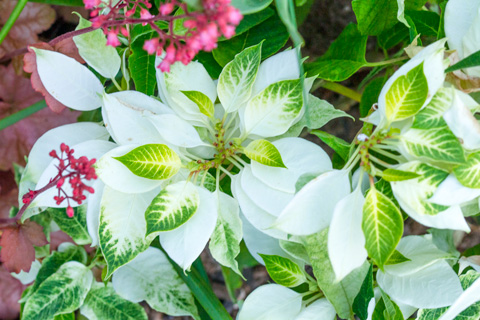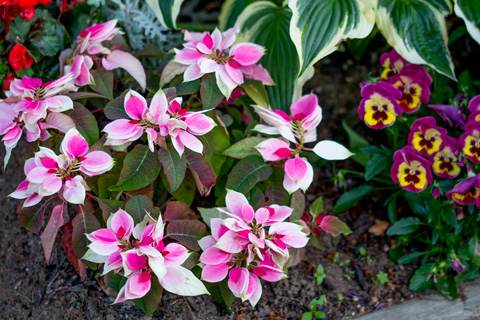12/1/2022
Summer … Poinsettias?
Lowell Halvorson

December 26. Poinsettias. Perfectly good, fully paid, yet unwanted. Taking them to the trash is so painful. Well, what if you took all those extra plants and mixed them into shade displays? Just keep them like houseplants over the winter, then plant them among the annuals and perennials under some of the trees. Here in Connecticut, I move mine outdoors when the daffodils are starting to pass.
It turns out that if you do add poinsettias to your shade garden, you surprise visitors strolling by the plantings. They always generate a conversation, sometimes an excited one, when folks see familiar plants in an unfamiliar place. Christmas Beauty is a bright shock of red, Winter Rose has scrunchies for bracts, Tapestry adds variegated leaves and the mysterious Princettias never cease to amaze. Many people are delighted by the discovery that, yes, poinsettias do garden well. How cool is that?
Building Your Surprise Display
Everybody, including industry professionals, is surprised that you can get away with such a scheme. Sales reps usually advise garden centers to throw out leftover poinsettias. The advice makes sense because reblooming the plants for next season is a huge pain. However, garden poinsettias have a different goal: keep existing the bracts as good spring color. At this point, you can practically see the exclamation points over the phone: “You can do that?” No emoji is necessary.
To convert your excess poinsettias into garden plants, keep them as houseplants over the winter. The bracts last a long time on healthy plants if you don’t push the new growth. Bracts color up because of long winter nights and you’ll have generous inventory on those.
Also, keep them away from direct sunlight (true in the house and the garden) because direct sunlight encourages bracts to fade and new greenery to kick into gear. About April, transition to a cool house (50F to 60F) if you haven’t done so already. If you harden them off, the plants will face the raw weather better.
Spring and Summer Performance
Despite their tropical and temperamental reputation, I find that poinsettias handle garden settings just like any other garden annual. Cold nights are no problem, as long as frost doesn’t hit (more like nemesias and less like Titan Vincas). Regular water isn’t a problem, either. I keep mine in natural rain, including under tree settings that are notoriously dry. Poinsettias aren’t xeriscaping candidates, but they don’t mind a tough stretch of dry days. They handle the same rainy weather as hostas, heucheras and tuberous begonias.
In fact, in a very un-tropical way, their Achilles’ heel is direct sun, not cold or water. The poinsettias I’ve killed have always been the ones I planted in full sun and the leaves crisped up pretty quickly. They can handle semi-sun gardens, but the overhead sun does encourage the green to reappear sooner rather than later. Older leaves darken into bronze and the bright green poinsettia leaves reach over top.
Their best performance occurs in full shade where the Christmas color continues into the summer. Think of gardens under trees where the grass doesn’t grow. Poinsettias’ bright colors are highly valuable because bright reds or pinks are so rare under there.
They also do well as tuck-in plants among taller perennials and shrubs where the overarching plants shade the ones underneath them. This is my favorite use of poinsettias—unexpected finds like Easter eggs.
Zag When Others Zig
I have to say this idea isn’t for everyone.
As a surprise and delight effort, it’s best used by a garden center that likes to unveil unusual concepts to their neighborhood. It’s also a display idea rather than a program one because, to the best of my knowledge, no one supplies poinsettia stock as a spring or summer product. So, as a sellable idea, inventory is pinched to what you can crib from the leftover Christmas market. But as a garden display idea, it has pretty good merit as customer butter.
Now, don’t take my experience as the last word. It’s mostly a personal tale backed up by a few curious growers who put some plants out on their decks to see what would happen. Their experiences shadow mine, but I’ve just started this journey myself. Breeders tell me that different varieties have different temperature and water tolerances, so your mileage may vary.
This isn’t to say that the garden poinsettia is an original idea, either. A few miles away, I found a deli owner who likes to buy the big ones and plant them outdoors as an impressive display to his entrance. He’s done so for nearly a decade, and boy, was he proud when I interviewed him. So if you wander across some garden poinsettias this spring, or if you give this idea a shot, give me a call. I am a curious bear.

Spotlight On: Princettia
The most intriguing cultivars came from Suntory’s Princettia, also available from Dümmen Orange (way in the back of the catalog). These poinsettias grow out very differently: multi-tone leaves walk in a zipper style along curving, wandering stems. No other spring annual offers this look and that color mix stays until frost, much longer than other poinsettias I planted.
In the United States, we usually find them in 4-in. pots, although Princettia Queen Pink is the big one, better suited for 6-in. pots. Princettia is a miniature poinsettia that translates well to bedding plant sizes, so I use this series as low color or filler in between larger perennials. You need to turn to other varieties if you want big volume or a tall presence.
I live in Connecticut, so I can usually get my Princettias into the ground around the time the daffodils bloom and the perennial geraniums start to color up for the season. They do best in full or mostly shade gardens, or even a dry garden under the cherry tree where the shade keeps the sun off the bracts and leaves. More sun will green up the leaves and fade away the color.
Other varieties like to push up new shoots of green and drop their previous colors. Not Princettias—they hang onto their current color-filled bracts, then extend their growing stem further out where new bracts keep emerging. This creates their signature zipper tracks of color.
As a result, none of my visitors ever pegged the Princettias for what they began as—poinsettias. They always noticed and talked about the plants as cool, neat, different, unusual, etc., but I had to fill them in on the origin story. Then they raised their eyebrows. In many ways, I think Princettias should sell as Summer Euphorbias to move them away from the novelty of Christmas in July. Nothing else in the spring or summer looks like Princettias and bright whites, pinks and reds are tough to find for deep shade. I think these plants could break away from the Christmas pack and compete on their own merits. GP
Lowell Halvorson is a consultant and writer in Fairfield, Connecticut, for retail and wholesale horticulture, specializing in business development. He will be contributing articles about the breeding community for GrowerTalks/Green Profit magazine. You can contact him at (203) 257-9345 or halvorson@triadicon.com.